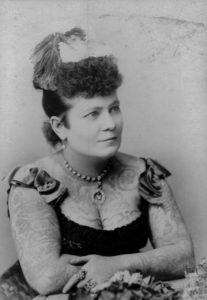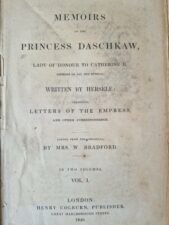It is often claimed that tattooed women are a symbol of modernity, defying the restricting beauty standards of society.[1] Nonetheless, more wide-ranging research reveals that this is a generalised and too simplistic a view of tattooed women. My research on the differing experiences of tattooed women of the nineteenth and twentieth century, therefore, suggests the magnitude of a so-far neglected area of research and the danger of perceiving the experiences of tattooed women as one homogenising group.
When examining anthropological records from the early twentieth century, it becomes evident that in most cases, tattoos on women were a symbol of femininity and fertility. For example, a childless Chukchee woman (indigenous people in Russia) would tattoo three parallel lines onto her chin ‘as a charm against continued sterility’.[2] In other parts of the world, young daughters were being tattooed as part of a ritual whilst sitting on their mother’s knees to create a lifelong bond, ensuring mother and daughter will not part ways in the afterlife.[3]
Other anthropological records of the nineteenth century display a more ethnocentric approach to tattoo practices. For instance, the British colony Burma, has proved to be a compelling site of research to British ethnographers interested in analysing gender roles. Jordanna Bailkin, for example, analysed the disparities between the different interpretations of tattoos. While the Chin women, who displayed prominent facial tattoos, contended that these tattoos only served decorative purposes, the British ethnographers considered them as ‘too ugly’ and found alternative justifications.[4] Towards the end of the nineteenth century, Burmese tattoo practices also started to receive greater attention in the British public. Bailkin argues that Burmese facial tattoos became the very symbol of resistance to governing powers, and British women in particular viewed Burmese tattoo practices as empowering.
Despite these developments, Western opinions on tattoos and tattooed women in particular, were mixed throughout the nineteenth century. There were some accounts and publications in favour of this fashion trend as can be seen in an article from the New York Herald from 1897 whose author claimed that without a tattoo ‘you cannot be au courant with society’s very latest fad’.[5] Nonetheless, there were also many outspoken critics of the tattooing practice, who were clearly concerned that this trend had caught on in American and British high society. A quote by the American author Samuel Ward McAllister from 1896 not only described this practice as ‘the most vulgar and barbarous habit the eccentric mind of fashion ever invented’ but also gave an example of how tattooed bodies were conceptualised differently depending on their social background. [6] His claim that ‘it may do for an illiterate seaman, but hardly for an aristocrat’, hints at the common belief at the time that the bodies of the upper classes were conceived to be superior to the working class. The physician and criminologist Cesare Lombroso also condemned the latest fashion trend and aimed his criticisms at the women of London’s high society, claiming in 1896 that ‘this style is not a good indication of the refinement and delicacy of the English ladies’. [7] Furthermore, referring to the pain commonly associated with getting a tattoo, Lombroso is seemingly troubled by the fact that upper class women could endure the pain of being tattooed. According to him, and much to his dismay, they did so purely for the ‘gratification of vanity’.[8]
Lombroso’s interest in tattoos did not just focus on the female body of the upper class. Like many criminologists of the nineteenth century, Lombroso dedicated his research to the classification of criminals. The body of the criminal now received much greater attention as it was believed that visible physical features, including tattoos, were an indicator of a deviant mind. In his book The Female Offender (1898) he asserted that whilst tattoos are very common among male delinquents, they are less likely to be found on the bodies of the opposite sex.[9] He goes on to argue that ‘tattooing among the lower class of prostitutes is frequent, but rare among the upper sort, and almost unknown in the ranks of the clandestine’ indicating once again that tattoos had no place in the higher classes of society.[10] However, his belief that higher ranking women are less likely to display tattoos is unconvincing, given there are several accounts of tattooed upper class women, such as Lady Randolph Churchill, mother of Winston Churchill, who had a fashionable tattoo on her wrist.[11]
The biggest paradox, however, is arguably found when analysing tattooed women in freak shows. Women quickly realised the potential of turning their tattooed skin into successful attractions, quickly overtaking their male counterparts in the business. One of those young women was Nora Hildebrandt, who started displaying her body in the United States in 1882. The perks of a successful career as a ‘tattooed lady’ were discussed in a newspaper clipping from 1884, in which it is said that following a tour in Mexico, Hildebrandt received (amongst other things) a pony, an eagle and a pet tiger.[12] However, this is only one aspect of the treatment of tattooed women. In order to display their tattooed bodies, they generally had to appear in more revealing clothes, which was arguably an attraction in itself in a moralistic Victorian society. [13] Much more interesting, however, is the fact that almost all of these tattooed ladies constructed horrific stories of how they got these tattoos, stories which frequently involved ‘tattoo rape’.[14] Hildebrandt, as recounted by Braunberger, claimed to have been abducted with her father by a Native American tribe where she was tied to a tree and her father was made to tattoo her every day for an entire year. The constructed stories of these women differed slightly, nevertheless, the apparent lack of agency remained prevalent.
Depriving a tattooed woman of her agency also becomes important when discussing the infamous rape of the late 1920s in Boston. The case was first brought to scholarly attention in Albert Parry’s book Tattoo: Secrets of a Strange Art (1930) and showed how deeply engrained some of Lombroso’s theories remained in society. Two men were charged with the rape of a young woman from a respectable family. Whilst there was no doubt that the two men were indeed guilty of raping her, a photograph revealed that that the woman had a butterfly tattooed on her leg. This evidence instantly led to the two men being acquitted while the woman was accused of misleading them with her tattoo, making them believe that she was a ‘loose character’, despite the fact that prior to this incident she was in fact a virgin. [14]
My research thus provides evidence that the experiences and treatment of tattooed women was both complex and varied. Bearing all these differing experiences in mind is important, when studying both the history of tattoos and women to avoid generalisations and / or neglect the experiences of the individual.
Klara Hengl recently completed her undergraduate degree in History and Social Anthropology at the University of Kent. With a particular interest in the history of the body and women’s studies, she plans on pursuing a Masters in Medical History to continue her interdisciplinary research.
[1] Margot Mifflin, Bodies of Subversion: A Secret History of Women and Tattoo (New York City: powerhouse Books, 1997, reprinted 2013), p.8. [2] Wilfrid Dyson Hambly, The History of Tattooing (H. F. & G. Witherby, 1925; reprinted 2009), p.217. [3] Ibid. [4] Jordanna Bailkin, ‘Making Faces: Tattooed Women and Colonial Regimes’, History Workshop Journal, 59 (2005) 33-59 (p. 37). [5] Albert Parry, Tattoo: Secrets of a Strange Art (New York: Simon and Schuster, 1933; reprinted 2006), p.103. [6] Christine Braunberger, ‘Revolting Bodies: The Monster Beauty of Tattooed Women‘, NWSA Journal, 12 (2000) 1-23 (p.6). [7] Cesare Lombroso, ‘The Savage Origin of Tattooing’, Popular Science Monthly Volume, 48 (1898) 793-903 (p.793). [8] Ibid., p.793. [9] Cesare Lombroso and William Ferrero, The Female Offender, (New York: D. Appleton and Company, 1898), p.115. [10] Ibid., p.120. [11] Claudia Springer, ‘Reviewed Work: Bodies of Subversion: A Secret History of Women and Tattoo’, Woman’s Art Journal, 21 (2003), 53-54 (p.53). [12] ‘Miscellaneous’, New York Clipper, 22 March 1884, p.6. [13] Braunberger, 1-23 (p.9). [14] Parry, p.3&4.

